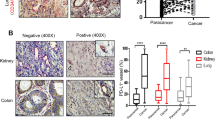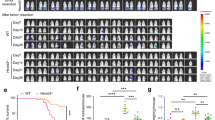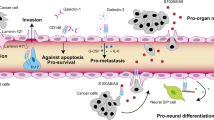Abstract
Melanoma cells facilitate endothelial gap formation, the first step during tumor transendothelial migration, which is mediated by both adhesion and endogenously produced chemokines (in particular, interleukin-8 (IL-8)). Tetraspanins are localized to the cell surface in cancer and participate in various functions including invasion of tissues mediated by secretion of cytokines and matrix metalloproteinases. However, little is known about the role of CD82 tetraspanins in malignant melanomas during cancer cell invasion. In this study, we investigated the functional importance of CD82 expression in melanoma-mediated gap formation by using cDNAs to induce CD82 expression in highly invasive melanoma cell lines. Results showed that CD82 expression inhibited melanoma cell-induced gap formation, melanoma cell extravasation in vitro and subsequent lung metastasis development in vivo. Mechanistic studies showed that inducible expression of CD82 in highly metastatic melanoma cells significantly increased p21 expression upon binding of Duffy antigen receptor group (DARC), inducing tumor cell senescence and interrupting IL-8-mediated vascular endothelial (VE)-cadherin disassembly. Taken together, these studies provide a rationale for using drug therapies that restore CD82 expression and inhibit IL-8 production to inhibit late-stage melanoma cell extravasation and subsequent metastasis development.
This is a preview of subscription content, access via your institution
Access options
Subscribe to this journal
Receive 50 print issues and online access
$259.00 per year
only $5.18 per issue
Buy this article
- Purchase on Springer Link
- Instant access to full article PDF
Prices may be subject to local taxes which are calculated during checkout






Similar content being viewed by others
References
Gray-Schopfer V, Wellbrock C, Marais R . Melanoma biology and new targeted therapy. Nature 2007; 445: 851–857.
Shevde LA, Welch DR . Metastasis suppressor pathways—an evolving paradigm. Cancer Lett 2003; 198: 1–20.
Chiang AC, Massague J . Molecular basis of metastasis. N Engl J Med 2008; 359: 2814–2823.
Brodland DG, Zitelli JA . Mechanisms of metastasis. J Am Acad Dermatol 1992; 27: 1–8.
Nicolson GL . Metastatic tumor cell attachment and invasion assay utilizing vascular endothelial cell monolayers. J Histochem Cytochem 1982; 30: 214–220.
Germano G, Allavena P, Mantovani A . Cytokines as a key component of cancer-related inflammation. Cytokine 2008; 43: 374–379.
Nagasawa K, Chiba H, Fujita H, Kojima T, Saito T, Endo T et al. Possible involvement of gap junctions in the barrier function of tight junctions of brain and lung endothelial cells. J Cell Physiol 2006; 208: 123–132.
Tsai YC, Weissman AM . Dissecting the diverse functions of the metastasis suppressor CD82/KAI1. FEBS Lett 2011; 585: 3166–3173.
Romanska HM, Berditchevski F . Tetraspanins in human epithelial malignancies. J Pathol 2011; 223: 4–14.
Singethan K, Schneider-Schaulies J . Tetraspanins: small transmembrane proteins with big impact on membrane microdomain structures. Commun Integr Biol 2008; 1: 11–13.
Xu C, Zhang YH, Thangavel M, Richardson MM, Liu L, Zhou B et al. CD82 endocytosis and cholesterol-dependent reorganization of tetraspanin webs and lipid rafts. FASEB J 2009; 23: 3273–3288.
Zoller M . Tetraspanins: push and pull in suppressing and promoting metastasis. Nat Rev Cancer 2009; 9: 40–55.
Liu WM, Zhang F, Moshiach S, Zhou B, Huang C, Srinivasan K et al. Tetraspanin CD82 inhibits protrusion and retraction in cell movement by attenuating the plasma membrane-dependent actin organization. PLoS One 2012; 7: e51797.
Shiwu WU, Lan Y, Wenqing S, Lei Z, Yisheng T . Expression and clinical significance of CD82/KAI1 and E-cadherin in non-small cell lung cancer. Arch Iran Med 2012; 15: 707–712.
Takaoka A, Hinoda Y, Sato S, Itoh F, Adachi M, Hareyama M et al. Reduced invasive and metastatic potentials of KAI1-transfected melanoma cells. Jpn J Cancer Res 1998; 89: 397–404.
Bandyopadhyay S, Zhan R, Chaudhuri A, Watabe M, Pai SK, Hirota S et al. Interaction of KAI1 on tumor cells with DARC on vascular endothelium leads to metastasis suppression. Nat Med 2006; 12: 933–938.
Lombardi DP, Geradts J, Foley JF, Chiao C, Lamb PW, Barrett JC . Loss of KAI1 expression in the progression of colorectal cancer. Cancer Res 1999; 59: 5724–5731.
Acosta JC, O’Loghlen A, Banito A, Guijarro MV, Augert A, Raguz S et al. Chemokine signaling via the CXCR2 receptor reinforces senescence. Cell 2008; 133: 1006–1018.
Singh S, Varney M, Singh RK . Host CXCR2-dependent regulation of melanoma growth, angiogenesis, and experimental lung metastasis. Cancer Res 2009; 69: 411–415.
Gabellini C, Trisciuoglio D, Desideri M, Candiloro A, Ragazzoni Y, Orlandi A et al. Functional activity of CXCL8 receptors, CXCR1 and CXCR2, on human malignant melanoma progression. Eur J Cancer 2009; 45: 2618–2627.
Peiper SC, Wang ZX, Neote K, Martin AW, Showell HJ, Conklyn MJ et al. The Duffy antigen/receptor for chemokines (DARC) is expressed in endothelial cells of Duffy negative individuals who lack the erythrocyte receptor. J Exp Med 1995; 181: 1311–1317.
Leong SR, Lowman HB, Liu J, Shire S, Deforge LE, Gillece-Castro BL et al. IL-8 single-chain homodimers and heterodimers: interactions with chemokine receptors CXCR1, CXCR2, and DARC. Protein Sci 1997; 6: 609–617.
Zijlstra A, Quigley JP . The DARC side of metastasis: shining a light on KAI1-mediated metastasis suppression in the vascular tunnel. Cancer Cell 2006; 10: 177–178.
Iiizumi M, Bandyopadhyay S, Watabe K . Interaction of Duffy antigen receptor for chemokines and KAI1: a critical step in metastasis suppression. Cancer Res 2007; 67: 1411–1414.
Zarbock A, Bishop J, Muller H, Schmolke M, Buschmann K, Van Aken H et al. Chemokine homeostasis vs. chemokine presentation during severe acute lung injury: the other side of the Duffy antigen receptor for chemokines. Am J Physiol Lung Cell Mol Physiol 2010; 298: L462–L471.
Liang S, Hoskins M, Khanna P, Kunz RF, Dong C . Effects of the tumor–leukocyte microenvironment on melanoma–neutrophil adhesion to the endothelium in a shear flow. Cell Mol Bioeng 2008; 1: 189–200.
Peng HH, Liang S, Henderson AJ, Dong C . Regulation of interleukin-8 expression in melanoma-stimulated neutrophil inflammatory response. Exp Cell Res 2007; 313: 551–559.
Dong C, Slattery MJ, Liang S, Peng HH . Melanoma cell extravasation under flow conditions is modulated by leukocytes and endogenously produced interleukin 8. Mol Cell Biomech 2005; 2: 145–159.
Waugh DJ, Wilson C . The interleukin-8 pathway in cancer. Clin Cancer Res 2008; 14: 6735–6741.
Li A, Dubey S, Varney ML, Dave BJ, Singh RK . IL-8 directly enhanced endothelial cell survival, proliferation, and matrix metalloproteinases production and regulated angiogenesis. J Immunol 2003; 170: 3369–3376.
Mantovani A, Allavena P, Sica A, Balkwill F . Cancer-related inflammation. Nature 2008; 454: 436–444.
Murdoch C, Monk PN, Finn A . Cxc chemokine receptor expression on human endothelial cells. Cytokine 1999; 11: 704–712.
Criscuoli ML, Nguyen M, Eliceiri BP . Tumor metastasis but not tumor growth is dependent on Src-mediated vascular permeability. Blood 2005; 105: 1508–1514.
Dejana E, Bazzoni G, Lampugnani MG . Vascular endothelial (VE)-cadherin: only an intercellular glue? Exp Cell Res 1999; 252: 13–19.
Gavard J . Breaking the VE-cadherin bonds. FEBS Lett 2009; 583: 1–6.
Peng HH, Hodgson L, Henderson AJ, Dong C . Involvement of phospholipase C signaling in melanoma cell-induced endothelial junction disassembly. Front Biosci 2005; 10: 1597–1606.
Khanna P, Yunkunis T, Muddana HS, Peng HH, August A, Dong C . p38 MAP kinase is necessary for melanoma-mediated regulation of VE-cadherin disassembly. Am J Physiol Cell Physiol 2010; 298: C1140–C1150.
Verin AD, Patterson CE, Day MA, Garcia JG . Regulation of endothelial cell gap formation and barrier function by myosin-associated phosphatase activities. Am J Physiol 1995; 269 (Partt 1): L99–108.
Acosta JC, Gil J . A role for CXCR2 in senescence, but what about in cancer? Cancer Res 2009; 69: 2167–2170.
Lleonart ME, Artero-Castro A, Kondoh H . Senescence induction: a possible cancer therapy. Mol Cancer 2009; 8: 3.
Fan T, Jiang S, Chung N, Alikhan A, Ni C, Lee CC et al. EZH2-dependent suppression of a cellular senescence phenotype in melanoma cells by inhibition of p21/CDKN1A expression. Mol Cancer Res 2011; 9: 418–429.
Giuliano S, Ohanna M, Ballotti R, Bertolotto C . Advances in melanoma senescence and potential clinical application. Pigment Cell Melanoma Res 2011; 24: 295–308.
Liu S, Yamauchi H . p27-Associated G1 arrest induced by hinokitiol in human malignant melanoma cells is mediated via down-regulation of pRb, Skp2 ubiquitin ligase, and impairment of Cdk2 function. Cancer Lett 2009; 286: 240–249.
Houben R, Ortmann S, Drasche A, Troppmair J, Herold MJ, Becker JC . Proliferation arrest in B-Raf mutant melanoma cell lines upon MAPK pathway activation. J Invest Dermatol 2009; 129: 406–414.
Gartel AL, Serfas MS, Tyner AL . p21-Negative regulator of the cell cycle. Proc Soc Exp Biol Med 1996; 213: 138–149.
Campisi J . Cellular senescence as a tumor-suppressor mechanism. Trends Cell Biol 2001; 11: S27–S31.
Ishikawa F . Cellular senescence, an unpopular yet trustworthy tumor suppressor mechanism. Cancer Sci 2003; 94: 944–947.
Roninson IB . Oncogenic functions of tumour suppressor p21(Waf1/Cip1/Sdi1): association with cell senescence and tumour-promoting activities of stromal fibroblasts. Cancer Lett 2002; 179: 1–14.
Singh RK, Gutman M, Radinsky R, Bucana CD, Fidler IJ . Expression of interleukin 8 correlates with the metastatic potential of human melanoma cells in nude mice. Cancer Res 1994; 54: 3242–3247.
Singh RK, Lokeshwar BL . Depletion of intrinsic expression of interleukin-8 in prostate cancer cells causes cell cycle arrest, spontaneous apoptosis and increases the efficacy of chemotherapeutic drugs. Mol Cancer 2009; 8: 57.
Singh RK, Varney ML . IL-8 expression in malignant melanoma: implications in growth and metastasis. Histol Histopathol 2000; 15: 843–849.
Huh SJ, Liang S, Sharma A, Dong C, Robertson GP . Transiently entrapped circulating tumor cells interact with neutrophils to facilitate lung metastasis development. Cancer Res 2010; 70: 6071–6082.
Weis S, Cui J, Barnes L, Cheresh D . Endothelial barrier disruption by VEGF-mediated Src activity potentiates tumor cell extravasation and metastasis. J Cell Biol 2004; 167: 223–229.
Tran MA, Gowda R, Sharma A, Park EJ, Adair J, Kester M et al. Targeting V600EB-Raf and Akt3 using nanoliposomal-small interfering RNA inhibits cutaneous melanocytic lesion development. Cancer Res 2008; 68: 7638–7649.
Sharma A, Tran MA, Liang S, Sharma AK, Amin S, Smith CD et al. Targeting mitogen-activated protein kinase/extracellular signal-regulated kinase kinase in the mutant (V600E) B-Raf signaling cascade effectively inhibits melanoma lung metastases. Cancer Res 2006; 66: 8200–8209.
Acknowledgements
We acknowledge Chris Goodrich who kindly provided technical support. We also acknowledge Dr Meenhard Herlyn for kindly providing WM35 and WM793 cells. We thank Dr Justin Brown for letting us use his Odyssey system to develop the western blots. This work was supported by NIH Grant CA-127892-01A1, American Cancer Society Grant RSG-04-053-01-GMC and The Foreman Foundation for Melanoma Research (GPR); NIH Grants CA-125707 (CD); and Johnson & Johnson Innovative Technology Research Seed Grant Program (CD and GPR).
Author information
Authors and Affiliations
Corresponding authors
Ethics declarations
Competing interests
The authors declare no conflict of interest.
Rights and permissions
About this article
Cite this article
Khanna, P., Chung, CY., Neves, R. et al. CD82/KAI expression prevents IL-8-mediated endothelial gap formation in late-stage melanomas. Oncogene 33, 2898–2908 (2014). https://doi.org/10.1038/onc.2013.249
Received:
Revised:
Accepted:
Published:
Issue Date:
DOI: https://doi.org/10.1038/onc.2013.249
Keywords
This article is cited by
-
Proteomics study on the protective mechanism of soybean isoflavone against inflammation injury of bovine mammary epithelial cells induced by Streptococcus agalactiae
Cell Stress and Chaperones (2021)
-
VE-Cadherin Disassembly and Cell Contractility in the Endothelium are Necessary for Barrier Disruption Induced by Tumor Cells
Scientific Reports (2017)
-
CD82 suppresses CD44 alternative splicing-dependent melanoma metastasis by mediating U2AF2 ubiquitination and degradation
Oncogene (2016)
-
Tetraspanin CD82: a suppressor of solid tumors and a modulator of membrane heterogeneity
Cancer and Metastasis Reviews (2015)
-
Nuclear Stiffening Inhibits Migration of Invasive Melanoma Cells
Cellular and Molecular Bioengineering (2014)



